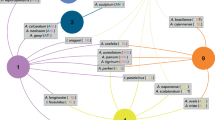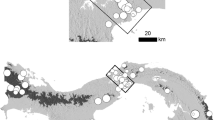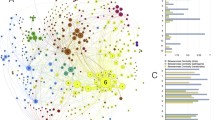Abstract
Patterns of host–parasite association are poorly understood in tropical forests. While we typically observe only snapshots of the diverse assemblages and interactions under variable conditions, there is a desire to make inferences about prevalence and host-specificity patterns. We studied the interaction of ticks with non-volant small mammals in forests of Borneo. We inferred the probability of species interactions from individual-level data in a multi-level Bayesian model that incorporated environmental covariates and advanced estimates for rarely observed species through model averaging. We estimated the likelihood of observing particular interaction frequencies under field conditions and a scenario of exhaustive sampling and examined the consequences for inferring host specificity. We recorded a total of 13 different tick species belonging to the five genera Amblyomma, Dermacentor, Haemaphysalis, Ixodes, and Rhipicephalus from a total of 37 different host species (Rodentia, Scandentia, Carnivora, Soricidae) on 237 out of 1,444 host individuals. Infestation probabilities revealed most variation across host species but less variation across tick species with three common rat and two tree shrew species being most heavily infested. Host species identity explained ca. 75 % of the variation in infestation probability and another 8–10 % was explained by local host abundance. Host traits and site-specific attributes had little explanatory power. Host specificity was estimated to be similarly low for all tick species, which were all likely to infest 34–37 host species if exhaustively sampled. By taking into consideration the hierarchical organization of individual interactions that may take place under variable conditions and that shape host–parasite networks, we can discern uncertainty and sampling bias from true interaction frequencies, whereas network attributes derived from observed values may lead to highly misleading results. Multi-level approaches may help to move this field towards inferential approaches for understanding mechanisms that shape the strength and dynamics in ecological networks.




Similar content being viewed by others
References
Adler GH (1998) Impacts of resource abundance on populations of a tropical forest rodent. Ecology 79:242–254
Anderson RM, May RM (1991) Infectious diseases of humans: dynamics and control. Oxford University Press, Oxford
Bersier LF, Banašek-Richter C, Cattin MF (2002) Quantitative descriptors of food-web matrices. Ecology 83:2394–2407
Blüthgen N, Klein A-M (2011) Functional complementarity and specialisation: the role of biodiversity in plant–pollinator interactions. Basic Appl Ecol 12:282–291
Blüthgen N, Menzel F (2006) Measuring specialization in species interaction networks. BMC Ecol 6:9. doi:10.1186/1472-6785-6-9
Clauset A, Moore C, Newman MEJ (2008) Hierarchical structure and the prediction of missing links in networks. Nature 453:98–101
Colwell RK, Futuyma DJ (1971) On the measurement of niche breadth and overlap. Ecology 52:567–568
Cumming GS (2002) Comparing climate and vegetation as limiting factors for species ranges of African ticks. Ecology 83:255–268
Cumming GS (2004) On the relevance of abundance and spatial pattern for interpretations of host–parasite association data. Bull Entomol Res 94:401–409
Durden LA (2006) Taxonomy, host associations, life cycles and vectorial importance of ticks parasitizing small mammals. In: Morand S, Krasnov BR, Poulin R (eds) Micromammals and macroparasites: from evolutionary ecology to management. Springer, Tokyo, pp 91–102
Durden LA, Merker S, Beati L (2008) The tick fauna of Sulawesi, Indonesia (Acari: Ixodoidea: Argasidae and Ixodidae). Exp Appl Acarol 45:85–110
Feinsinger P, Spears EE, Poole RW (1981) A simple measure of niche breadth. Ecology 62:27–32
Geevarghese G, Mishra AC (2011) Haemaphysalis ticks of India. Elsevier, London
Gelman A, Hill J (2007) Data analysis using regression and multilevel/hierarchical models. Cambridge University Press, New York
Gillespie T, Chapman CA (2006) Prediction of parasite infection dynamics in primate metapopulations based on attributes of forest fragmentation. Conserv Biol 20:441–448
Golicher DJ, O’Hara RB, Ruíz-Montoya L, Cayuela L (2006) Lifting a veil on diversity: a Bayesian approach to fitting relative-abundance models. Ecol Appl 16:202–212
Hoogstraal H (1964) Studies of Southeast Asian Haemaphysalis ticks (Ixodidea, Ixodidae). Redescription, hosts, and distribution of H. traguli Oudemans. The larva and nymph of H. vidua W. and N. Identity of H. papuana toxopei Warburton (new combination). J Parasitol 50:765–782
Hurlbert S (1978) The measurement of niche overlap and some relatives. Ecology 59:67–77
Ings TC, et al. (2009) Ecological networks—beyond food webs. J Anim Ecol 78:253–269
Klompen JSH, Black WC IV, Keirans JE, Oliver JH Jr (1996) Evolution of ticks. Annu Rev Entomol 41:141–161
Kohls GM (1957) Malaysian parasites. XVIII. Ticks (Ixodoidea) of Borneo and Malaya. Stud Inst Med Res Malays 28:65–94
Krasnov BR, Stanko M, Morand S (2007) Host community structure and infestation by ixodid ticks: repeatability, dilution effect and ecological specialization. Oecologia 154:185–194
Lafferty KD, Dunne JA (2010) Stochastic ecological network occupancy (SENO) models: a new tool for modeling ecological networks across spatial scales. Theor Ecol 3:123–135
Lande R, Engen S, Sæther B-E (2003) Stochastic population dynamics in ecology and conservation. Oxford University Press, Oxford
LoGiudice K, Ostfeld RS, Schmidt KA, Keesing F (2003) The ecology of infectious disease: effects of host diversity and community composition on Lyme disease risk. Proc Natl Acad Sci USA 100:567–571
Lunn D, Spiegelhalter D, Thomas A, Best N (2009) The BUGS project: evolution, critique and future directions. Stat Med 28:3049–3067
MacKenzie DI, Nichols JD, Lachman GB, Droege S, Royle JA, Langtimm CA (2002) Estimating site occupancy rates when detection probabilities are less than one. Ecology 83:2248–2255
Mason NWH, Mouillot D, Lee WG, Wilson JB (2005) Functional richness, functional evenness and functional divergence: the primary components of functional diversity. Oikos 111:112–118
Mouillot D, Krasnov BR, Poulin R (2008) High intervality explained by phylogenetic constraints in host parasite webs. Ecology 89:2043–2051
Olesen JM, Bascompte J, Elberling H, Jordano P (2008) Temporal dynamics in a pollination network. Ecology 89:1573–1582
Petney TN, Kolonin GV, Robbins RG (2007) Southeast Asian ticks (Acari: Ixodida): a historical perspective. Parasitol Res 101:S201–S205
Poulin R, Mouillot D (2005) Combining phylogenetic and ecological information into a new index of host specificity. J Parasitol 91:511–514
Rao CR (1982) Diversity and dissimilarity coefficients: a unified approach. Theor Pop Biol 21:2443
Robinson WS (2009) Ecological correlations and the behavior of individuals. Int J Epidemiol 38:337–341 [reprinted from (1950) Am Sociol Rev 15(3):351–357]
Royle JA, Nichols JD, Kéry M (2005) Modelling occurrence and abundance of species when detection is imperfect. Oikos 110:353–359
Sehgal RNM (2010) Deforestation and avian infectious diseases. J Exp Biol 213:955–960
Sodhi NS et al (2010) Conserving Southeast Asian forest biodiversity in human-modified landscapes. Biol Conserv 143:2375–2384
Thébault E, Fontaine C (2010) Stability of ecological communities and the architecture of mutualistic and trophic networks. Science 329:853–856
Vázquez DP, Poulin R, Krasnov BR, Shenbrot GI (2005) Species abundance and the distribution of specialization in host–parasite interaction networks. J Anim Ecol 74:946–955
Vázquez DP, Melian CJ, Williams NM, Blüthgen N, Krasnov BR, Poulin R (2007) Species abundance and asymmetric interaction strength in ecological networks. Oikos 116:1120–1127
Wells K, Pfeiffer M, Lakim MB, Kalko EKV (2006) Movement trajectories and habitat partitioning of small mammals in logged and unlogged rain forests on Borneo. J Anim Ecol 75:1212–1223
Wells K, Kalko EKV, Lakim MB, Pfeiffer M (2007a) Effects of rain forest logging on species richness and assemblage composition of small mammals in Southeast Asia. J Biogeogr 34:1087–1099
Wells K, Smales LR, Kalko EKV, Pfeiffer M (2007b) Impact of rain-forest logging on helminth assemblages in small mammals (Muridae, Tupaiidae) from Borneo. J Trop Ecol 23:35–43
Wells K, Lakim MB, Beaucournu JC (2011) Host specificity and niche partitioning in flea–small mammal networks in Bornean rainforests. Med Vet Entomol 25:311–319
Wenger SJ, Freeman MC (2008) Estimating species occurrence, abundance, and detection probability using zero-inflated distributions. Ecology 89:2953–2959
Wikle CK (2003) Hierarchical Bayesian models for predicting the spread of ecological processes. Ecology 84:1382–1394
Wilson DE, Reeder DM (eds) (2005) Mammal species of the world. A taxonomic and geographic reference, 3rd edn. Johns Hopkins University Press, Baltimore
Acknowledgments
We thank the Economic Planning Unit Malaysia for research permission and Sabah Parks and Yayasan Sabah for various kinds of support during field work. We are especially thankful to all staff and people at the different field sites for their warm hospitality. In particular, we thank Alim Biun, Fred Tuh Yit Yu, Jickson Sankin, Awang Matamin, Suati Selimon, Aloysius Mail and Jadda Suhaimi. We thank Brigitte Fiala and K. Eduard Linsenmair for academic and logistic support. We appreciate the mentoring and friendship of the late Elisabeth K. V. Kalko; she sadly passed away, to our disbelief, while this study was being performed. Field work was supported by the German Academic Exchange Service (DAAD).
Author information
Authors and Affiliations
Corresponding author
Additional information
Communicated by Wolf Mooij.
Electronic supplementary material
Below is the link to the electronic supplementary material.
Rights and permissions
About this article
Cite this article
Wells, K., O’Hara, R.B., Pfeiffer, M. et al. Inferring host specificity and network formation through agent-based models: tick–mammal interactions in Borneo. Oecologia 172, 307–316 (2013). https://doi.org/10.1007/s00442-012-2511-9
Received:
Accepted:
Published:
Issue Date:
DOI: https://doi.org/10.1007/s00442-012-2511-9




